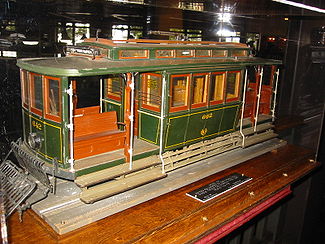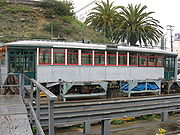
Market Street Railway Company
Encyclopedia

Bus
A bus is a road vehicle designed to carry passengers. Buses can have a capacity as high as 300 passengers. The most common type of bus is the single-decker bus, with larger loads carried by double-decker buses and articulated buses, and smaller loads carried by midibuses and minibuses; coaches are...
operator in San Francisco. The company was named after the famous Market Street
Market Street (San Francisco)
Market Street is an important thoroughfare in San Francisco, California. It begins at The Embarcadero in front of the Ferry Building at the northeastern edge of the city and runs southwest through downtown, passing the Civic Center and the Castro District, to the intersection with Corbett Avenue in...
of that city, which formed the core of its transportation network. Over the years, the company was also known as the Market Street Railroad Company, the Market Street Cable Railway Company and the United Railroads of San Francisco.
The company should not be mistaken for the current Market Street Railway
Market Street Railway (nonprofit)
Market Street Railway is San Francisco Municipal Railway's 1,200-member nonprofit preservation partner. It relies on private contributions to help keep San Francisco’s famed historic streetcars of the F Market & Wharves line and the national landmark cable cars running to this day.Market Street...
, which is named after its predecessor but is actually a legally unconnected non-profit support group for San Francisco's heritage streetcar
Heritage streetcar
Heritage streetcars or heritage trams are a development of the heritage railways that are becoming popular across the world. As with modern streetcar systems, the vehicles are referred to as trams or tramcars in the United Kingdom, Australasia and certain other places , but as streetcars or...
lines.
History
The franchise for what would become the Market Street Railway was granted in 1857 to Thomas HayesThomas Hayes (19th century)
Thomas Hayes was a land owner in the western addition to San Francisco in the 19th century. Hayes Valley in the western addition and Hayes Street are named after him. He was the original franchisee of the Market Street Railway, and county clerk between 1853 and 1856. The franchise for what would...
. The line was the first horsecar
Horsecar
A horsecar or horse-drawn tram is an animal-powered streetcar or tram.These early forms of public transport developed out of industrial haulage routes that had long been in existence, and from the omnibus routes that first ran on public streets in the 1820s, using the newly improved iron or steel...
line to open in San Francisco, opened on July 4, 1860, as the Market Street Railroad Company. A few years later, the line was converted to steam power utilizing a steam engine that was part locomotive and part passenger car, and a trailer car.
Following the opening of the cable hauled
Cable car (railway)
A cable car or cable railway is a mass transit system using rail cars that are hauled by a continuously moving cable running at a constant speed. Individual cars stop and start by releasing and gripping this cable as required...
Clay Street Hill Railroad
Clay Street Hill Railroad
The Clay Street Hill Railroad was the first successful cable hauled street railway. It was located on Clay Street, a notably steep street in San Francisco in California, and first operated in August 1873....
in 1873, pressure grew to convert the city's horsecar lines to the new form of traction. In 1882, Leland Stanford
Leland Stanford
Amasa Leland Stanford was an American tycoon, industrialist, robber baron, politician and founder of Stanford University.-Early years:...
and associates bought the Market Street Railroad Company and converted its lines to cable haulage. In the process, the company's name was changed to the Market Street Cable Railway Company. This company was to grow to become San Francisco's largest cable car operator. At its peak, it operated five lines all of which converged into Market Street to a common terminus at the Ferry Building
Ferry Building
The San Francisco Ferry Building is a terminal for ferries that travel across the San Francisco Bay and a shopping center located on The Embarcadero in San Francisco, California. On top of the building is a large clock tower, which can be seen from Market Street, a main thoroughfare of the city...
; during rush hours a cable car left that terminus every 15 seconds.
However transit technology was still moving on, and the new electric streetcar quickly proved to cheaper to build and operate than the cable car, and capable of climbing all but San Francisco's steepest hills. In 1893, Stanford died and the company was taken over by the Southern Pacific Railroad
Southern Pacific Railroad
The Southern Pacific Transportation Company , earlier Southern Pacific Railroad and Southern Pacific Company, and usually simply called the Southern Pacific or Espee, was an American railroad....
. The company was again renamed to the Market Street Railway Company, and began the process of converting its lines to electric traction. In 1895 the company placed a newspaper advertisement in the San Francisco Examiner offering horse cars for $20 ($10 without seats). Many of these became the basis for the impromptu community built from streetcars called Carville-by-the-Sea
Carville (San Francisco, California)
Carville, also known Carville-by-the-Sea, was an impromptu neighborhood in what is now the Outer Sunset District of San Francisco, California...
.
Conversion to electricity was resisted by opponents who objected to what they saw as ugly overhead lines on the major thoroughfares of the city center. At 5:12 am on April 18, 1906, those objections were swept away as the great San Francisco earthquake
1906 San Francisco earthquake
The San Francisco earthquake of 1906 was a major earthquake that struck San Francisco, California, and the coast of Northern California at 5:12 a.m. on Wednesday, April 18, 1906. The most widely accepted estimate for the magnitude of the earthquake is a moment magnitude of 7.9; however, other...
struck. The race to rebuild the city allowed the company to replace all but the steepest of its cable car lines with electric streetcar lines.
By this stage, the company had changed hands again, and become the United Railroads of San Francisco (URR). Over the years many independent lines had been absorbed, including the Clay Street Hill Railroad
Clay Street Hill Railroad
The Clay Street Hill Railroad was the first successful cable hauled street railway. It was located on Clay Street, a notably steep street in San Francisco in California, and first operated in August 1873....
, the San Francisco and San Mateo Electric Railway
San Francisco and San Mateo Electric Railway
The San Francisco and San Mateo Electric Railway was the first electric streetcar company in San Francisco, California. The company was only in business for ten years, starting in 1892 until its merger into the United Railroads of San Francisco ....
, the Presidio & Ferries Railway, and the Ferries and Cliff House Railway. Ironically the earthquake that brought so many benefits to the company also sowed the seeds of its demise, as the independent Geary Street, Park & Ocean Railway
Geary Street, Park & Ocean Railway
The Geary Street, Park and Ocean Railway was one of the first cable car operators in San Francisco. Operation commenced in 1880, and the route soon proved quite popular. The line was purchased by the Market Street Railway in 1887. In 1912, the city declined to renew the franchise and instead...
was acquired by the city and became in 1912 the beginning of the San Francisco Municipal Railway
San Francisco Municipal Railway
The San Francisco Municipal Railway is the public transit system for the city and county of San Francisco, California. In 2006, it served with an operating budget of about $700 million...
(Muni). By 1918, and assisted by the construction of several tunnels under the city's hills, Muni was in direct competition with the URR down the length of Market Street. The two operators each operated their own pair of rail tracks down that thoroughfare, which came to be known as the 'roar of the four'. The two Market Street Railway tracks were on the inside and the two San Francisco Municipal Railway tracks were on the outside.
Competition, labor troubles and a bad accident in 1918 led to the reorganisation of the URR, to re-emerge again as the Market Street Railway Company. This continued to operate electric streetcars throughout the city, the Powell St. cable car lines, and a growing fleet of buses. But relations were not good with the city, who controlled their franchises, and in 1944 the company sold all its assets and operations to Muni.
Surviving vehicles

- Car 578 was built in 1895 by Hammond Car Company. A single-truck (four-wheel), California-type car (open end sections, enclosed middle compartment). After serving many years as a work car, it was eventually restored to its original form by the Muni, and is still run for special events and charters.
- Car 798 was built in the company's own shops in 1924. this car was sold for scrap after World War 2World War IIWorld War II, or the Second World War , was a global conflict lasting from 1939 to 1945, involving most of the world's nations—including all of the great powers—eventually forming two opposing military alliances: the Allies and the Axis...
. Used as a residence and jewelery store in the California town of ColumbiaColumbia, CaliforniaColumbia is a former California Gold Rush boomtown located in the Sierra Nevada foothills. The central portion of the town is preserved as a California state historic park and a National Historic Landmark that preserves the original, gold-rush-town flavor of the town, once dubbed the "Gem of the...
, it was reacquired in 1984 and is currently undergoing restoration for occasional use on the F MarketF MarketThe F Market & Wharves line is one of several light rail lines in San Francisco, California. Unlike the other lines, the F line is operated as a heritage streetcar service, using exclusively historic equipment both from San Francisco's retired fleet as well as from cities around the world...
line.
See also
- San Francisco cable car systemSan Francisco cable car systemThe San Francisco cable car system is the world's last permanently operational manually operated cable car system, in the US sense of a tramway whose cars are pulled along by cables embedded in the street. It is an icon of San Francisco, California...
- San Francisco Railway MuseumSan Francisco Railway MuseumThe San Francisco Railway Museum is a local railway museum located in the South of Market area of San Francisco.This small museum features exhibits on the antique streetcars of the F Market & Wharves and national landmark cable cars that continue to run along the city's major arteries. The museum...
- San Francisco Municipal RailwaySan Francisco Municipal RailwayThe San Francisco Municipal Railway is the public transit system for the city and county of San Francisco, California. In 2006, it served with an operating budget of about $700 million...
- Market Street Railway (nonprofit)Market Street Railway (nonprofit)Market Street Railway is San Francisco Municipal Railway's 1,200-member nonprofit preservation partner. It relies on private contributions to help keep San Francisco’s famed historic streetcars of the F Market & Wharves line and the national landmark cable cars running to this day.Market Street...
- San Francisco Municipal Railway fleetSan Francisco Municipal Railway fleetWith five different modes of transport from many different vendors, the San Francisco Municipal Railway, or Muni as it is commonly known, runs one of the most diverse fleets of vehicles in the United States. Roughly 1,000 buses, 200 streetcars, and 40 cable cars see active duty...
Further reading
- Smallwood, Charles The White Front Cars of San Francisco Glendale, California:1978 Interurban (Interurban Special #44) ISBN 0-0916374-32-7--a complete history of the Market Street Railway company with numerous illustrations and maps

